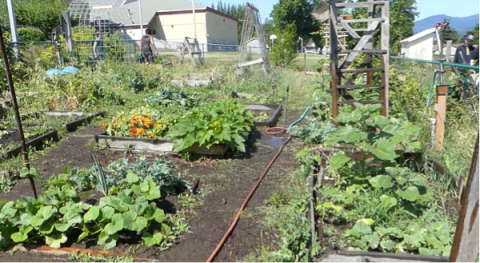June 7th to June 11th- Oregon Blog
After exploring the city of Portland we were ready to head out East to conquer the mountains and the coasts that Oregon has to offer. A re-occurring theme this week was sustainable food processes and access. In earlier blogs you may have noticed we have been dealing with social and infrastructural sustainability. Once we left the city our knowledge began to expand towards farming, food, food culture and the importance of accessible healthy food choices.
In the first week of class we watched a Ted Talk by Ron Finley that focused guerrilla gardening in South Central LA. One of the messages he highlighted that has stuck with us since the beginning of our trip is: "kids grow kale, kids eat kale". We saw this first hand when we had the opportunity to tour and explore Hood River Middle School. Our lessons at the school were not only from the inspiring, Michael Becker, but from his students. After Michael introduced the FACS program (Farm and Conservation Sciences) we were given tours by the students, explaining all the aspects of the program that they participate in. This program allows the students to learn about growing food, different agriculture practices, and maintaining ecosystems. Its also gives the students the freedom to experience these practices first hand and learn independently. From growing their own vegetables, maintaining a green house and aquaponic system, understanding rain water catchments and the mechanisms behind solar panels, these kids have a first hand introduction to real world permaculture practices.

One of the most exciting parts of this program is that the students help inspire and create the biological systems that they maintain. Not only has the garden been successful by functioning as a biological system through all seasons, but the program itself is a stacked function. The program teaches the students the educational factors that go along with the growing process as well as taking a step further and teaching the students financial and marketing skills to help sell their products at the local farmers market. Another important aspects of this program is that the students are encouraged to take risks and start their own projects. In the words of Michael Becker the kids are encouraged to turn “obstacles into opportunities.” From cooking their own food, and taking recipes home to their families, the students learn the value of the Do It Yourself (DIY) culture.

This program has led to even more then just practical skills for the students. It inspires teamwork and self-development by encouraging the students to work in teams, and assist each other in any way they can. This aids in creating a sense of place for students, which will further foster a sense of responsibility for the community they live in and enhance the protection of its natural surroundings.

We then visited Chef Christopher Holen at the Baked Alaska restaurant in Astoria, Oregon. It was here that we enjoyed a delicious lunch prepared for us using sustainably grown fruits and vegetables, and freshly caught salmon. Holen prides himself on letting good ingredients speak for themselves, and this was definitely clear through his simplistic yet delicious courses. Our first course included a water cress salad, dressed in olive oil, salt and pepper, and topped with berries and melon. Our second course consisted of a salmon, asparagus and tomatoes that was marinated in salmon stew, which incorporated a broth made out of all of the parts of a.


While he was preparing our meals, Chris Holen regaled us with the inspirational story of the revitalization of the sleepy town of Astoria, and how the story coincided with the establishment of their first restaurant. The story of Chris and Astoria really begins when him and his wife took a pit stop to the town on the way to a summer serving soup in Alaska. During this stop, they fell in love with the sleepy fishing town by the sea and immediately decided to buy out an old cafe that, just like the rest of the town, was in need of a revamp. After that summer they transformed the cafe into Baked Alaska’s first location. Their success quickly grew as word began to spread about his lunch and breakfast joint. Just as their restaurant did, Astoria began to revitalize as old theatres and hotels took on new ownership and became newly restored to capture the essence of their vibrant past. Baked Alaska quickly outgrew its small cafe lot and so Chris and his partner moved their restaurant to its current location, which is right on the waterfront of Astoria. The restaurant now contains a bar, restaurant, pizza joint and special event dining area. Chris has gained international attention and hopes to keep expanding his restaurant through a salt and seasoning line, which is already started up, and potentially a cooking show.

The story of Astoria shows how the process of urban renewal can shape a city or town. For example, what was once a booming port city was eventually deprived of industry due to the resurrection of San Francisco. This sleepy fishing town eventually reached its true potential when it was transformed back into a tourist destination thanks to the revitalization and establishment of its restaurants, hotels, theatres, museums and schools.

In further exploration of our investigation into natural food systems we left Seaside to explore the Willamette Valley Vineyard and Winery. With sustainability as a high priority for the vineyard we were able to explore the environmentally friendly practices that take place at this beautiful location. We even got to experience the taste of Oregon’s main grape, Pinot Noir.

In this vineyard, they go against the industry standards of using pesticides and herbicides. The wine industry typically uses these practices to ensure that every wine grape is uniform. Spraying fertilizer is a sure way for the vineyard to maximize the grape’s potential. Willamette Valley has a Live Certification and a Salmon Safe Certification. The Live Certification reflects low input viticulture endocrinology, which focuses on the grape growing and also the wine making. It also focuses on paying staff a living wage for their workers work. Furthermore, the Willamette vineyard focuses on decreasing water pollution by not putting anything in their water that will damage or contaminate the watershed no the ecosystem. This means that they don’t use herbicides or insecticides and only use 1 fungicide a season. In order to protect their plants they use biological systems to protect their grapes such as beetles, mites and hawks. Unfortunately, not all diseases and pest can be controlled in an organic fashion. Sometimes these organic protectors don’t work and the vineyard will take a hit by getting rid of the diseased fruit. Willamette Valley vineyard is willing to take that economic loss in order to ensure that they are all organic.

At the Willamette Valley vineyard, they believe that good grapes come from good soil. In order to ensure their soil quality, they compost all their waste from the their wine making process. They have a massive compost bin, behind their main building and they use that compost to spread on their fields. The most interesting thing about the use of the compost is that in order to enhance their soil they actually inoculate it with proprietary microorganisms and fungus. The soil and compost that they add is a huge factor in what makes Willamette valley vineyards wine so good.
Overall, rural Oregon and its activities really highlighted the importance of the Urban Growth Boundary and agricultural land reserves. Without these two concepts, urban sprawl could encroach farmland and the land reserves preserve the good land that Oregon has. This makes Oregon unique and heavily linked to is farmland. Seeing the rural areas of Oregon gave us a lot of insight to how Portland runs so well in terms of providing local organic food for its people.

